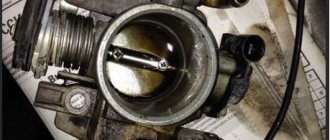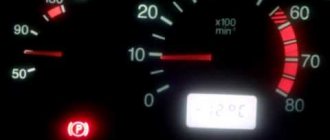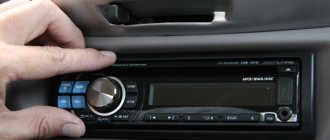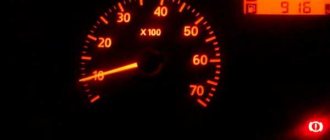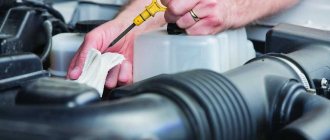There can be many reasons why a car stalls while driving. This could be a malfunction of the fuel system, or problems with the engine or ignition system. Many reasons for engine stalling are possible only on a carburetor system, and some are only possible on an injection system. The nature of the engine's operation at the moment before stopping can suggest the direction of troubleshooting. Often, after stopping, it is possible to restart the engine and continue driving. This behavior should also be involved in the logic of searching for the problem of why the car stalled. It should be noted that an injection car has more reasons for sudden breakdowns.
Sudden engine stop
If the engine was running normally while the car was moving, and suddenly the car stalled, then the following may have happened:
- clogged carburetor jets;
- fuel pump failure;
- broken timing belt;
- malfunction of the crankshaft position sensor;
- malfunction of the idle speed controller;
- malfunction of the ignition distribution system.
Looking for reasons
All of the above reasons, with the exception of a breakdown of the crankshaft sensor, can be determined independently in a minimum of time. First of all, you need to understand whether the combustible mixture enters the combustion chambers of the engine. To do this, you need to unscrew and examine the spark plugs. If the spark plugs are dry, then the cause is most likely in the fuel system. In a carbureted car, the cause most often lies in the carburetor. There are many reasons, ranging from clogged fuel jets to lack of fuel in the float chamber. The fuel level in the float chamber is controlled by a needle valve connected to the float. The float may cling to the chamber body and not open the valve.
Clogging of the needle valve or jets can be caused by the ingress of foreign unfiltered particles or tar deposits as a result of using low-quality fuel. Resins are washed off using aerosol cans with carburetor cleaner, and blockages are washed off with a stream of air from the compressor.
Cleaning the nozzle holes with metal wire is strictly prohibited. The burrs left by the wire will lead to changes in the characteristics of the jets and will require their replacement and subsequent carburetor adjustment.
Wet spark plugs indicate that the engine has a working fuel system.
You should immediately check the ignition system for the presence of a spark. If all the spark plugs have traces of fuel and a spark, then conclusions can be drawn about the serviceability of the ignition and fuel supply systems. It is worth warning that the malfunction of a single spark plug or spark plug wire cannot lead to the engine stopping. This happens if the ignition distributor - distributor, module or ignition coil - fails.
The camshaft drive belt can be viewed by removing its cover. On many cars, a broken timing belt is accompanied by a strong blow when stopping. This occurs as a result of uncoordinated movement of the valves and piston and their mutual impacts. The pistons do not have grooves, which is why they collide with the valves. On such engines, special attention should be paid regularly to checking the condition of the belt. Some engines have grooves on the pistons, so a break in the timing belt goes completely unnoticed for them.
The collector shaft position sensor can only be checked by installing a new one on the car. None of the engine sensors will cause the engine to stop anymore, since the on-board controller has several backup operating algorithms and will ensure engine operation, albeit with increased fuel consumption and reduced power. At first, you can continue driving with such breakdowns.
The operation of the electric fuel pump of injection cars is checked by the presence of fuel in the fuel rail.
Problems of injection engines
Sometimes the car stalls while driving during sudden acceleration on fuel-injected cars with a small amount of fuel in the gas tank. Why does this happen? Because the tank in such cars is located horizontally, and even 10 liters of gasoline form a thin layer. During sharp acceleration, especially on an uphill slope, the fuel is pressed to the rear wall of the gas tank, the gas pump picks up air, and the car stops. Since fuel consumption is at its maximum during acceleration, the pressure in the fuel rail drops almost instantly and the engine stops. After stopping the car, the engine starts without problems.
Fuel pump
If the fuel pump does not work, then, of course, the car stalls. The carburetor will work perfectly, but no one gives it gas. On fuel-injected cars, the fuel pump is located under the rear seat. On carburetor engines - near the camshaft (since it is driven by it). If it stops working, the engine may idle normally, but when the speed increases, it will definitely stall. However, if the gasoline pump is completely worn out, the engine will not start at all. To get rid of this malfunction, it is necessary to either repair the pump or replace it completely, which is the most effective. As for carburetor engines, the pump diaphragm drive rod can wear out greatly.
Checking the fuel pump relay
Much more often the fuel pump relay breaks down. To check it, you need to turn the ignition switch with the engine off. A click should be heard in the area of the relay, and within a few seconds the fuel pump will start operating. If there is a click, but the pump does not work, the contacts in the relay may be burnt. This can be checked with an ohmmeter with the relay de-energized and after applying 12 V voltage to its winding from the battery terminals. Open contacts should show infinity, and closed contacts should show resistance in fractions of an ohm. If the relay is working properly, you need to check the ground connection to the fuel pump.
Electrical equipment
The problem of stopping the engine may also be due to a malfunction of electrical equipment. In particular, oxidation may occur at the battery terminals. Whether old cars or new ones, they all need maintenance and careful care. Consequently, the contact deteriorates as the resistance increases, and this leads to the engine stalling. The battery itself may also fail. In the same case, if the generator does not produce the required current, the entire electrical network of the car switches to power from the battery. If you do not immediately see a light on, indicating that there is no charging, the car will continue to move. Given that the lights are on and the ignition system is running, after a while the battery will be completely discharged and the engine will stop. You will have to charge the battery and also completely repair the generator.
Idle air control malfunction
A malfunction of the idle air control when the vehicle is moving stops the engine when the gas pedal is released and the throttle is closed.
You can check the regulator by removing it from the fuel system. A working regulator should show a resistance between the terminals of about 20–80 Ohms. When connecting the terminal with the ignition on, the regulator rod should make some movement.
For the first time, in order to drive the car to the service station without outside help, you need to remove the terminals from the regulator and manually, through several attempts, find such a position of the rod when the engine idles steadily so that the car does not stall when releasing the gas.
Intermittent operation
Stopping the engine is often preceded by interruptions in normal operation. If the fuel pump fails or the remaining fuel in the fuel tank runs out before stalling, the engine begins to jerk because the fuel pump picks up air along with the remaining fuel. A clogged fuel filter can manifest itself in different ways. At idle or while driving at low speed, the engine operates normally, but when accelerating or under heavy load, the filter’s throughput is no longer enough, and a lean mixture enters the cylinders, causing the car to stall while driving. To check the flow of fuel in injection engines, it is necessary to measure the pressure in the fuel rail. It should not be less than the set value for a given engine type.
A clogged air filter also affects operation in the same way.
An incorrectly adjusted carburetor produces an over-rich mixture, which can result in flooding of the spark plugs, causing them to fail.
As a result of incorrect valve adjustment, filling with low-quality gasoline or with an unacceptable octane number, burnout of the valves may occur. Usually the valves in one of the cylinders burn out. The engine starts to stall, suddenly loses power and may stall. Burnout of valves in two or more cylinders causes an immediate engine stop. This malfunction is checked using a compression meter in each cylinder. A reduced compression value will tell you which cylinder has failed.
A modern car is equipped with a catalytic converter for exhaust gases. If the converter is destroyed, the exhaust gases cannot leave the combustion chamber, which will also lead to a shutdown. You can check the catalyst only by removing it from the exhaust system.
Summary
As you can see, there can be many reasons why the engine stops while driving. The driver, like a doctor, must take into account and analyze all the “symptoms” in order to establish an accurate “diagnosis” of the car. If the diagnosis is unclear and there is not enough repair experience, you should contact specialists at a service station.
Car owners often find themselves in a situation where the engine suddenly stalls, whether the car is driving or idling. From this article you will learn about the reasons for engine stopping, diagnostic methods, and repair methods.
Reasons for stopping the engine at idle
Car owners and service station workers agree that the reasons for engine stalling can be:
- malfunction of the idle speed sensor, or its partial malfunction;
- malfunction of the throttle position sensor;
- presence of blockage in the throttle valve;
- clogging of the carburetor or injector (depending on the type of car).
It happens that the problem may be low quality fuel or its absence in the tank, as well as other malfunctions. If the breakdown is more serious than it seems, then it is better to contact a service station.
Carburetor engine
Carburetor is a component of the internal combustion engine power system designed to mix flammable liquid with air and supply it to the engine cylinders. The operating principle of such an engine is that the fuel, compressed in the combustion chamber, is ignited by an electric spark. Based on the number of cyclic cycles, carburetors are divided into four-stroke, two-stroke and four-stroke with a half-turn of the crankshaft. In carburetor engines, problems with idle stop occur mainly due to mechanical failure or simple contamination of engine parts.
What to do if the car stalls at idle
Hose between manifold and VUT
First of all, you need to check the hose going to the vacuum brake booster and its valve. To do this, you need to remove the hose and try to blow it out with your mouth. If the air flows in one direction and not in the other, then everything is fine. It is also worth checking the vacuum brake booster and its membrane. If they fail, they are replaced.
Make sure the throttle body and air filter are clean. To change a dirty filter, you can first try to shake it out and see the result immediately; if the car stalls when stopping at traffic lights due to lack of air, then the situation will improve a little. And to check the operation of the damper, you will have to remove the throttle assembly and see how it fits. Over time, it becomes covered with a thick layer of soot. Cleaning should help in this case.
So it’s worth removing and inspecting the level of contamination of the idle air regulator. It often happens that it leaves a gap for air, or simply gets stuck in one position due to wear somewhere in the middle. If so, then try cleaning it.
To check the crankcase ventilation valve, you need to remove the ventilation hose and check the valve on the cover. It simply becomes clogged with oil deposits. Regular cleaning often helps.
Remove and check the distributor. You need to check the contact group, the gaps between the contacts, the insulation of the wires, the condition of the terminals, and whether there is moisture inside. On carburetor cars, you also need to check the carburetor settings so that it maintains idle speed, as well as its general condition. In particular, cameras and float. If the carburetor is dirty, clean it with carb cleaner.
On a fuel-injected car, it is advisable to dismantle and check the performance of the injectors. If they are simply clogged, then they need to be cleaned. And to determine which sensor is faulty, you first need to check for errors in the ECU memory using an electronic scanner. If there are errors, then you need to look at their decoding, which may indicate a faulty sensor. Well, each sensor has its own verification algorithm.
Diagnostic sequence
There are no exact recommendations for the diagnostic sequence. If the engine stalls periodically, it is better to wait a little time and try to find out what the problem is. It is not difficult to determine a malfunction in the operation of an internal combustion engine - electronic diagnostic systems allow the electronic control unit to record problems. Verification methods based on visual and auditory observations should be kept in mind. The presence of extraneous noise, changes in the color of gas exhaust and other signs indicate a malfunction of the engine. Car owners with extensive driving experience know that minor faults lead to big problems - major engine repairs or complete replacement. Periodic inspections of parts and components of the unit, which are recommended to be carried out once a week, help to avoid such problems:
- check the level of engine oil and antifreeze;
- inspect for damage and ruptures of tips, connectors, hoses;
- monitor the operation of gaskets and seals.
How to avoid stalling at a traffic light as a beginner
Many novice drivers have a question about how not to stall at a traffic light due to poor driving skills and the ability to start with a manual transmission. To avoid such problems, here are the following tips:
- Depress the clutch fully (important!!!) just before engaging first gear;
- You can press the clutch at a traffic light as soon as the yellow light turns on;
- In neutral gear or with the clutch already depressed, press the gas pedal once or twice in order to increase the oil pressure in the engine and enrich the fuel mixture;
- select the optimal engine speed at the start (for a flat surface they are about 1500 rpm, when climbing - more, when descending - less, you can also navigate by the sound of the engine);
- you need to depress the clutch pedal smoothly, without jerking; you must not drop the clutch at the moment of starting;
- when the clutch “grabs” you need to fully depress the clutch pedal and at the same time add gas to accelerate the car (you can even add gas a little earlier).
All these skills should be practiced until they become automatic, but it is better to do the training away from dense city traffic!
Trouble-shooting
Often there is no fundamental difference which engine is installed in a vehicle - the reasons that the engine stalls will be the same. In carburetor-type engines, a common reason for the engine stopping at idle may be an unadjusted drive, a dirty needle valve, or other problems. To eliminate such malfunctions and improve engine performance, change the fuel filter regularly. If the solenoid valve fails, the speed twitches or drops completely.
When the characteristic clicking sound is not heard when connecting, it is better to replace the valve. In diesel engines, the main role is played by the high pressure fuel pump. If this unit fails, the quality of the fuel, the condition of the electrical wiring, glow plugs and other parts are checked, and the fuel filter is changed. In injection engines, the air filter is first cleaned; it is possible that it will have to be replaced. If vibration is felt at idle, it is recommended to replace the gasket. Also, to eliminate the causes of engine shutdown, the injectors on the engine or on a special device are washed.
avtoexperts.ru
As a rule, when the engine stalls while driving, car owners begin to check the fuel filter, fuel pump, spark plugs, etc. This is correct, since the reason is most often on the surface. But what if standard actions did not produce a positive result? We suggest that you familiarize yourself with some variants of malfunctions that are less common and, as a rule, lead drivers to bewilderment.
Under the hood of a car
The engine can stall while driving only for three reasons:
1. Problems with fuel supply (poor quality mixture, unstable supply, etc.).
2. No spark.
3. Problems in the mechanical part of the engine.
As for mechanical breakdowns, as a result of which the engine may stall while driving, these include engine jamming and timing belt breakage. All of them are accompanied by a roar from under the hood and further complete failure of the internal combustion engine. Therefore, it is impossible to make a mistake in diagnosis.
But there are many more reasons for the absence/instability of a spark or problems with fuel, and they are not always on the surface, so we will consider them further.
Problems in the electrical part - looking for a bad contact
Often, motorists are faced with a situation where the engine runs smoothly, does not lose power and starts easily, but sometimes, out of the blue, it suddenly stalls while driving. As a rule, the problem manifests itself when driving on an uneven road, for example, the car “catches” a hole and immediately stalls.
The reason for this malfunction is trivial - poor contact in the electrical circuit. Most often, the ground disappears, that is, the wire that is attached to the body. Therefore, it is enough to “tighten” the contact or clean it, and the problem disappears. You can attach an additional wire going from the engine to the body.
Lubricate electrical contacts
You should also carefully inspect the remaining terminals and contacts in the circuit. Often, all problem areas are visible even visually - they are heavily oxidized, dirty, or have obvious signs of burning or mechanical defects in the braid. For example, in a Toyota RAV, yours truly had to deal with a situation where the car itself stalled while on the road, and after that it completely refused to start for some time. After some time, the engine began to start perfectly the first time, and again worked as if nothing had happened.
This behavior of the car was completely confusing. As a result, a wire with a frayed braid was discovered behind the right headlight, which goes to the IGN2 relay. The cause of the damage to the wire turned out to be the electric headlight leveler, or rather, its connector, which touched the wire and chafed the braid when moving.
Broken wire
The most unpleasant thing in such situations is that the malfunction cannot be identified through computer diagnostics. Therefore, calls to the service station, sometimes multiple times, do not bring a positive result.
It should be noted that such symptoms sometimes occur due to problems in the electronic part, the so-called “brains”. However, they are easily identified during computer diagnostics.
Fuel supply problems
Failure of the vacuum booster membrane Drivers are often perplexed - why does the car stall when the brake is pressed? It would seem, what does the braking system have to do with engine performance? In fact, it has - the vacuum brake booster is connected to the intake manifold via a vacuum hose.
Vacuum brake booster
If the vacuum booster membrane fails, when you press the brake sharply, it does not have time to create a vacuum. As a result, some of the air from the brake system enters the combustible mixture, thereby greatly depleting it. This causes the engine to stall. As a rule, replacing the gaskets and membrane eliminates the problem. But sometimes the vacuum hose also needs to be replaced.
Air duct depressurization
In modern cars, even a depressurized air duct corrugation can cause a malfunction. This is due to the fact that if it is damaged, air begins to be sucked in, bypassing the mass air flow sensor (MAF). As a result, it reports incorrect data to the control unit and, as a result, the car stalls.
Broken air duct corrugation
It must be said that such a problem manifests itself not only while driving, but also at idle. The engine begins to work unstably - the speed “floats”, and the engine periodically stalls.
Throttle damper malfunction
There are situations when the engine stalls while changing speed, when the speed is reset. They literally “fail” to a critical point. This usually happens due to a malfunction of the throttle damper. The latter ensures a smooth return of the throttle valve to its original position, and thereby eliminates speed dips.
To make sure that the damper is to blame for such a malfunction, you must perform the following steps:
1. Warm up the engine well.
2. Open the throttle valve with your hands and release it sharply.
If the damper is working properly, the throttle valve should quickly reach almost its original position, then slow down, and finally reach the dead center within 1-2 seconds. If the throttle valve immediately returns to its original position, the damper must be replaced.
Throttle damper
If the damper is not installed in your car, and the problem occurs only after the engine reaches very high speeds, the engine control unit may be the cause. The malfunction can correct itself if you smoothly release the gas while driving at such speeds. This will lead to the block “learning on its own” to react correctly in such situations.
Lambda probe malfunction
A lambda probe, or simply an oxygen sensor, evaluates the quality of the combustible mixture by analyzing the exhaust gases, or more precisely, the oxygen content in them. It is this that often becomes the reason that the engine stalls while driving, has difficulty starting, loses traction, or becomes excessively “gluttonous.”
In the photo - lambda probe
In principle, the symptoms of a malfunction of this sensor can be very different, as a result of which it is difficult to make a correct diagnosis on your own. Therefore, it is necessary to use special diagnostic equipment.
These are, perhaps, all the most common, but at the same time, not typical reasons why an engine may stall while driving.
